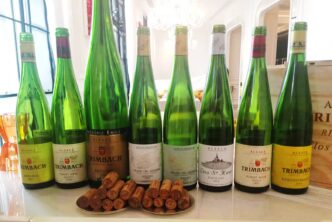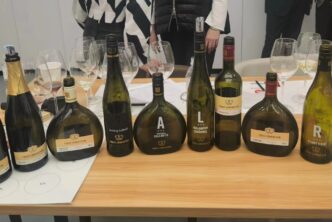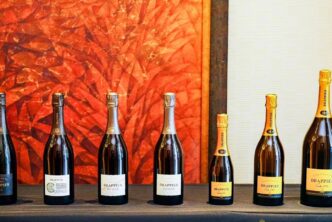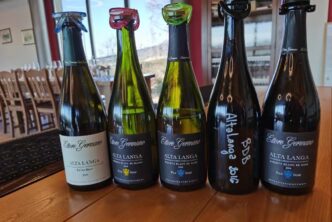In the second part of this article devoted to the wines of the highly esteemed and sought-after world-famous Georges Roumier estate, we present the quintessence of its prestigious vineyard holdings – the Grand Cru wines, as well as the Chambolle-Musigny “super” 1 Cru Les Amoureuses. It’s worth pointing out again that in this amazing lineup of wonderful bottles, it is the Bonnes Mares that is probably the most astonishing wine. Christophe Roumier is truly one of the world’s grandest vignerons and winemakers, and his wines allow those lucky enough to taste them regularly to deepen their understanding of the magical terroirs he farms.
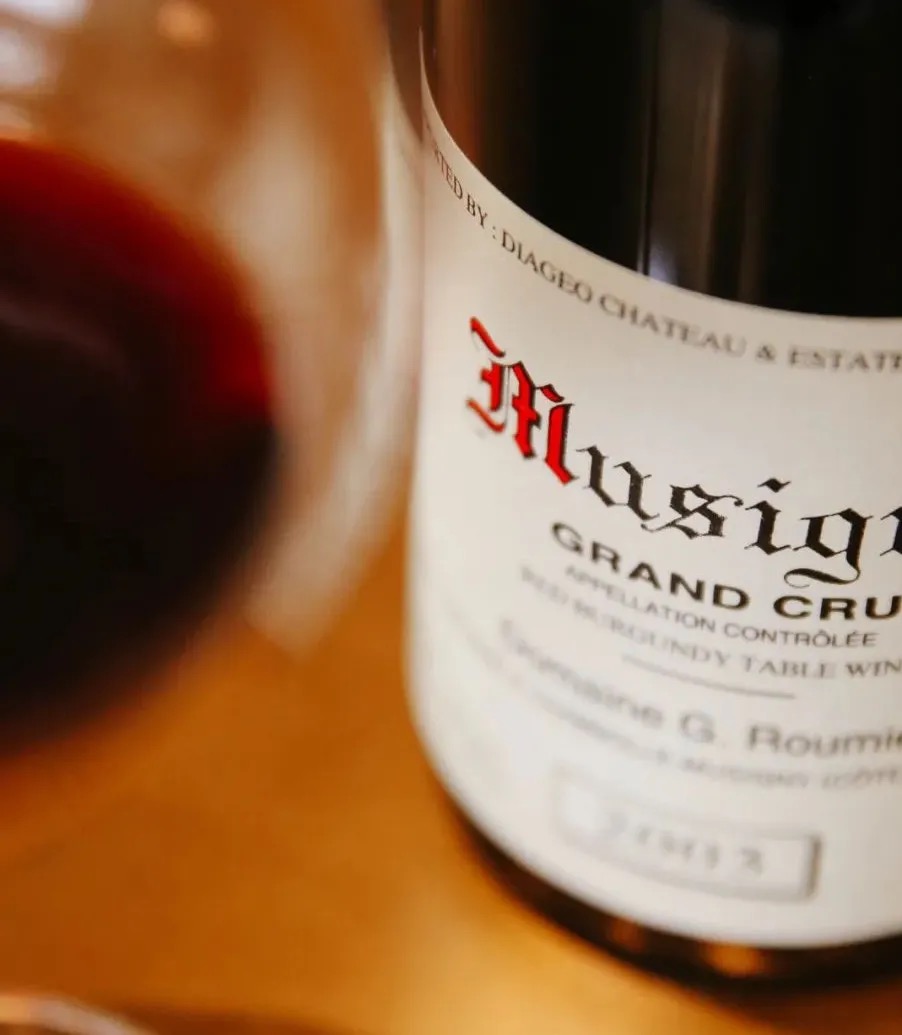
The crus and the wines
Ruchottes-Chambertin Grand Cru
Size: 0.5436 ha
Production: about 3000 bottles/year
Exposition/Altitude: east-facing, 20 degrees, 285-300 m
Soil: subsoil of limestone clay with many rocks, topsoil with many stones
Vines: 40 years old on average, Guyot
Vinification: hand-picked and manually selected; 65% destemmed; punch down during fermentation; only wild yeast fermentation; no filtration or clarification; barrel aging for 16 months, 30% new oak barrels, the rest are 2-8 years old barrels.
This Grand Cru is located in the village of Gevrey-Chambertin, where it is one of the (count them!) nine Grand Crus. Of all these grand crus, Ruchottes-Chambertin is the one that has the highest altitude. Its soil is very stony, and it is well-known for delivering a refined, mineral style of red Burgundy. Roumier has been farming this Grand Cru parcel about 0.54 hectares large [obtained from Michel Bonnefond through a metayage collaboration: many estates in Burgundy farm vineyards that they do not own and will pay the vineyard’s owner rent is paid in the form of wine (all or in part). This is why you can find exactly the same wine labeled with two different names since 1977. Importantly, be aware that differently from what is reported on many websites, Roumier only labels his name on one third but not two thirds of the vineyard, according to the official website of the domaine. The other two thirds are labeled “Michel Bonnefond” (but again, it is the same wine.). Annual production therefore is about 3000 bottles (including both labels) and it’s naturally a difficult wine to find on the market.
Christophe Roumier Ruchottes-Chambertin Grand Cru 2011 94

Serving: pour out one glass and leave the rest to breathe for 2.5 hours
Tasting note: The wine opens with powerful aromas of fresh red cherry and rose petals; in the mouth, offers some light red bean paste flavor and some minerality on the finish. The tannins are extremely fine and translucent; after 2.5 hours of airing in the bottle, the wine shows subtle and complex changes, with the freshness and elegance of the aromas and fruit flavors boasting outstanding delicacy and transparency. A hint of underlying, relatively harder tannins, bring some astringency, but also mineral energy and linear power. This is a very refined and gentlemanly wine that expresses precisely the terroir of Ruchottes-Chambertin, a high-altitude and highly typical Gevrey village grand cru, that is completely in contrast to the very different, more feminine style of Chambolle-Musigny’s wines, for example. Still needs another 2-3 years for all the tannins to soften and integrate so as to achieve entry into its peak drinking window. A rare wine that really lives up to its name, which the minerality speaks of rocks and minerals (“ruchottes” and “ruches” derive from the word rochers or rocks). Drinking window: 2023-2041
Jean-Pierre Mathieu (Christophe Roumier) Charmes-Chambertin Grand Cru “Aux Mazoyères”
Size: 0.2716 ha
Production: about 1000 bottles/year
Exposition/Altitude: gentle slope facing east, 275m
Soil: limestone clay
Vines: 20 years old on average, Guyot
This Roumier wine is made from grapes grown in the upper and middle part of the Mazoyères-Chambertin Grand Cru, but is labeled as Charmes-Chambertin (this is legally allowed) as the terroir is closer to the latter’s and wine’s style is hedonistic, rich, smooth and pleasant (hence in keeping with the wines of the Charmes Chambertin grand cru). Roumier has been farming and producing wine from this 0.27ha Grand Cru parcel since 1985 through a metayage (sharecropping) collaboration with Jean-Pierre Matthieu. That is why you will find two different labels out on the market, but it’s always exactly the same wine. Given the small vineyard holding, there are unfortunately only about 1000 bottles produced of this beauty a year (including both labels). According to Claude Kolm of The Fine Wine Review, starting from the 2018 vintage Christophe Roumier can label the whole production of this parcel with his own name.
Vinification: hand-picked and manually selected; 100% destemmed; skin punch down during fermentation; only wild yeast fermentation; no filtration or clarification; 16 months of barrel aging, 30% new barrels, the rest are 2-8 years old.
Christophe Roumier Charmes-Chambertin Grand Cru Aux Mazoyères 2007 93

Serving: pour out one glass and leave the rest to breathe for 2.5 hours
Tasting note: The wine opened with a straightforwardly perfumed red cherry nose, then showcased generous red fruit flavors with a rich and hedonistic texture, tasting significantly broader and fuller than the 2011 Ruchottes-Chambertin; fairly open right out of the gate, there was no need to decant, and was poured into glass after 2.5-hour breathing in the bottle. Very young and energetic for a 2007 wine, finishing long with refined red cherry nuances complicated by a hint of orange. I liked how this evolved in the glass to show a transparent and mineral base and a sense of masculine power, clearly a Gevrey wine (and not in the style of Chambolle, for example); because of the relatively young vines of this plot at that time (one third of the vines were replanted in 1991, 2000 and 2011 respectively, such that the 2007 amounted to only two-thirds of the current production and was therefore an even rarer wine back then than it is today, with only 400 bottles produced) about 50% was produced from 16-year-old vines and the other 50% from older vines planted in 1935. That fact recognized, while this wine clearly surpasses all of Roumier’s 1er Cru wines in terms of its structure and density of fruit, it is not as deep and powerful as the Ruchottes-Chambertin and even less so than Roumier’s Les Amoureuses. But there’s no doubt this rare Grand Cru is still a wonderful wine from what was a difficult vintage. Drinking window: now – 2025+
Domaine Georges Roumier Chambolle-Musigny 1er Cru Les Amoureuses
Size: 0.3963ha
Production: about 1600 bottles/year
Exposition/Altitude: east-facing, 15 degrees, 270m
Soil: subsoil of limestone clay, topsoil is a very thin layer of clay with many stones
Vines: 40 years old on average, Guyot
Vinification: hand-picked and manually selected; 70% destemmed, skin punch down during fermentation; only wild yeast fermentation; no filtration or clarification; barrel ageing 16 months, 25% new oak, rest 2-8 years old oak.
“Les Amoureuses” is undoubtedly the most famous of all the twenty-four 1er Crus of Chambolle-Musigny. Located on a gently sloping terrace, it is divided into two parts by a geological fault (the cliff is indicated by the arrows in the picture below) with a drop of several meters. Roumier’s parcel is located on the upper part that extends to Les Musigny, the subsoil of which is very close to that of Musigny. In fact the 1er Cru Les Amoureuses vineyard is almost as famous as the Musigny Grand Cru, world-famous for its classic style of refined and silky tannins and ethereal vitality. And though its wines offer relatively earlier accessibility than those of Musigny, almost no one doubts Amoureuses is a terroir of Grand Cru level.
 The location of Les Amoureuses, credit: Diary of a wine buyer
The location of Les Amoureuses, credit: Diary of a wine buyer
Domaine Georges Roumier Chambolle-Musigny 1er Cru Les Amoureuses 2009 97

Serving: pour out one glass and leave the rest to breathe for 3 hours
Tasting note: The nose is slightly closed at the beginning, but opens to showcases a very pure and delicate aroma of rose petal, with herbal scents hinting at ripe stems. Poured into glass after a 3-hour stint breathing in the bottle, boasts constantly changing and layered aromas that make you feel like you’ve been dropped into a sea of flowers and silk. Black spices slowly emerge and complement building notes of rose and cherry, with a cool hint of camphor weaving in and out. In the mouth, the wine is surprisingly fresh and pure, with flavors similar to the aromas and a silky texture with a soft and mineral underpinning that nicely supports and spreads the flavors on the long back end. This is about as close to the classic expression of Musigny’s wines as being like “an iron fist in a velvet glove”, but the wine of Les Amoureuses is not quite as solemn as that, expressing its noteworthy charm in a more feminine and cleverish way (no wonder that some of the vignerons of Chambolle say that Les Amoureuses is the “daughter” and Musigny is the “hostess”). This wine is obviously still in its very young teenage stage of development, but already boasts a persistent changeability in the glass and a lingering aftertaste of haunting elegance. It’s hard not to fall in love with this wine. Drinking window: 2028-2044+
Domaine Georges Roumier Chambolle-Musigny 1er Cru Les Amoureuses 1999 96
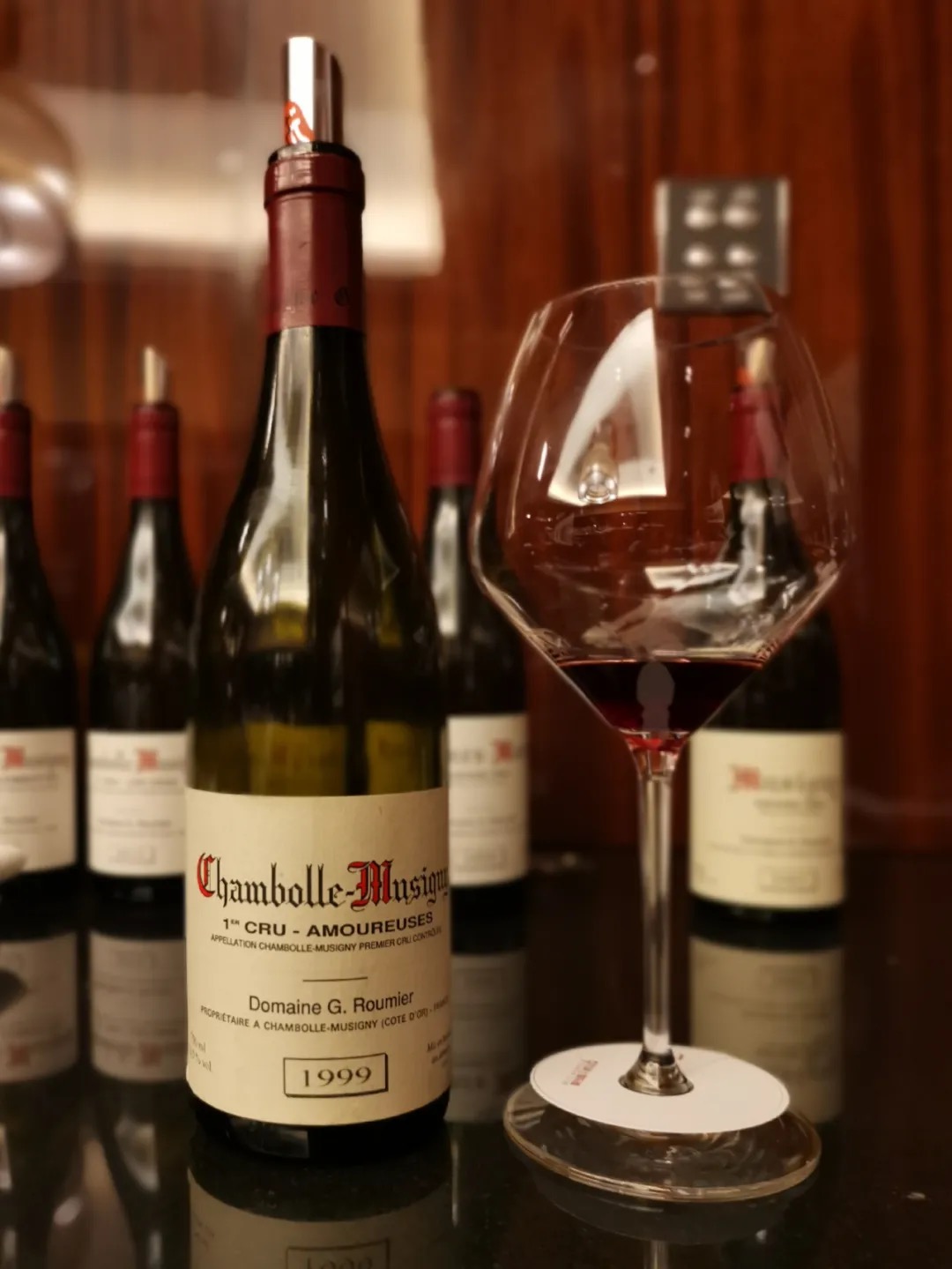
Serving: pour out one glass and leave the rest to breathe for 3 hours
Tasting note: This wine opens with a pure and delicate nose of rose petal and black cherry, but changes constantly showing more and more changes shades and layers with aeration and time. When it’s poured in the glass after breathing in the bottle for 3 hours, it slowly reveals complicating elements of animal fur and musk to the red fruit and floral aromas and flavors. Not unlike a walk in the forest, this wine’s vitality is such that it brings to mind images of a deer leaping through a flower-and fruit-filled forest. Currently drinking at its peak, and so charming that I found it difficult to put down my glass without continuously sipping and sniffing it. Comparing it with the equally magnificent 2009, we can tell how good the latter will be in 10 years’ time when it too will have reached its peak. The most impressive feature of the 1999 is its excellent complexity and overall harmony, as well as the emergence of complicating animal fur and musk notes that lift it to another level compared to the also excellent but younger 2009. There’s nothing more I can say about this great wine except that it really is an unforgettable piece of art. Drinking window: now-2029+
Domaine Georges Roumier Bonnes Mares Grand Cru
Size: 1.3919 ha
Production: about 5000 bottles/year
Exposition/Altitude: east-facing, 15-20 degree, 270-310m
Soil: chalk marl on the upper slopes, clay limestone on the lower slopes
Vines: 40 years old on average, Guyot
Vinification: hand-picked and manually selected; 50% destemmed; skin punch down during fermentation; only wild yeast fermentation; no filtration or clarification; barrel ageing for 16 months, 40% new barrels, the rest 2-8 years barrels.
Bonnes Mares is one of the two Grand Crus of Chambolle-Musigny, located on the north side of the village, next to the famous Clos de Tart monopole Grand Cru of Morey-Saint-Denis. There are generally two types of terroirs existing in this Bonnes Mares: the “white soil” on the upper slopes is underlain by calcareous chalk marl rich in fossilized shells, while the “red soil” on the lower slopes is underlain by clayey-limestone and Jurassic Bathonian compact bedrock. The “red soil” gives the wine a rich, full-bodied style and red fruit notes (and in some years, black fruit), while the “white soil” leads to more expressive notes of spice, white flowers and even red peony, with a peppery touch. The fusion of the two results in a well-framed and complete wine with both great fruit and minerality, combining the power of Morey-Saint-Denis with the complexity of Chambolle-Musigny.
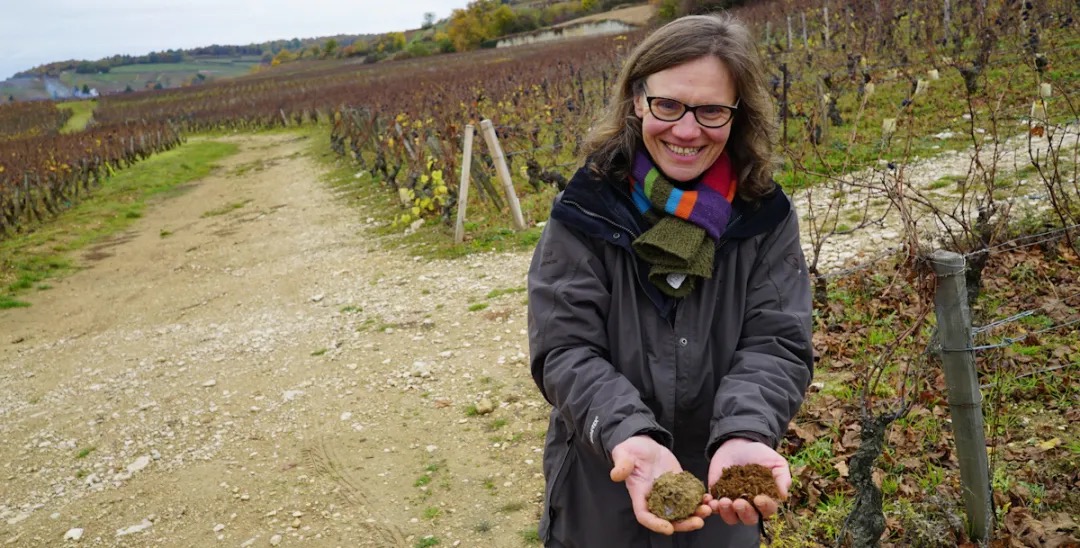 French geologist Françoise Vannier-Petit shows the different “white” and “red” soils in her hands.
French geologist Françoise Vannier-Petit shows the different “white” and “red” soils in her hands.
By overlapping the geological map made by the French geologist Françoise Vannier-Petit and the plot map of Domaine Georges Roumier, we obtain the following map. The five light red blocks show the location of the Bonnes Mares plots owned by the Domaine Georges Roumier. The green blocks show the areas of the “white soil”, and the brown blocks show the “red soil”. It is noteworthy that the two types of soils are not bounded by the border separating Chambolle and Morey and that the “white soil” area is significantly smaller than the “red soil” area. Domaine Georges Roumier is very unique in having a relatively higher percentage of the “white soil” terroir; Christophe Roumier chooses to vinify them separately and then blends them before bottling. This is the most interesting information relative to the Bonnes Mares terroir and is of key importance in understanding the wines made from this Grand Cru.
 Photo: Soil type map of Domaine Georges Roumier
Photo: Soil type map of Domaine Georges Roumier
Domaine Georges Roumier Bonnes Mares Grand Cru 2008 96

Serving: pour out one glass and leave the rest to breathe for 3 hours
Tasting note: As is often the case with the wines of Bonnes Mares, I was worried a little bit that this wine might be closed at the beginning. But I was reassured by the freshness and purity of the rose petals and red fruit notes that emerged upon opening, with a touch of oak, and already showing a magnificent, open structure on the palate. This boasts excellent concentration, beautiful acidity, and great balance, with incredible vigour not unlike the undercurrent beneath a peaceful lake’s surface. I find that Christophe’s use of whole bunches with stems in fermentation is particularly subtle and plays an important role in the expression of his terroirs. There’s no need to decant this, just let it breathe in the bottle for 3 hours. When poured in the glass, it offers an explosive nose of fresh roses, plus complicating notes of camphor leaves and rose calyx, plus a cool nuance deriving from the stems. A multilayered wine that changes constantly in the glass, with subtle and ever-changing floral notes resting on top of a transparently pure and solid foundation of minerality and acidity. The impressive mineral subtlety that this wine exudes in spades might be a result of the calcium-rich “white soil” terroir; to use a figurative metaphor, it is very much like “a blooming rose growing on crystal”. A beautiful wine of truly amazing persistent vitality that just lasts and lasts in the glass, this Bonnes Mares made me understand why some great vignerons believe Bonnes Mares is one of the greatest terroirs in the world and that it’s still under-appreciated currently. Christophe Roumier’s wine is undoubtedly the benchmark for this Grand Cru. With a high percentage of “white soil” in his plots, he has a greater emphasis on expressing the subtlety and vitality of the Grand Cru. And so, while other version of Bonnes Mares may be quite masculine, Roumier’s Bonnes Mares (not just in 2008) is clearly a very elegant more feminine (but still very vigourous) wine. And as the result of relatively larger volumes produced compared to the estate’s other wines, Roumier’s Bonnes Mares’ price is not as expensive as that of his Musigny or Les Amoureuses. Considering the greatness of this wine, it is my opinion that it is the Bonnes Mares that is undoubtedly Roumier’s most collectable wine with and the undeniably greatest potential for value appreciation. Drinking window: 2023-2048
Domaine Georges Roumier Musigny Grand Cru
Size: 0.0996 ha
Production: about 360 bottles/year
Exposition/Altitude: east-facing, 15 degrees, 280-310m
Soil: limestone clay topsoil, dense rocky subsoil with white pebbles Vines: average 70 years old, dominant shelf type The Musigny Grand Cru is one of the two Grand Crus of Chambolle-Musigny, located on a rocky slope just uphill of the Clos de Vougeot Grand Cru, sandwiched between the first growths Les Amoureuses (of Chambolle-Musigny) and Echezeaux (of Vosne-Romanée). Georges Roumier’s plot is located to the north (see the white box on the map below), and its oldest vines were planted in 1905. This estate’s Musigny is characterized by a generous and spirited aroma, with a silky soft tannic texture and great potential for ageing.
Vinification: hand-picked and manually selected; 35%-50% destemmed; skin punch down during fermentation; only wild yeast fermentation; no filtration or clarification; barrel aging for 16 months, 40-60% new barrels in some vintages (with no new oak at all sometimes), the rest of the barrels are 2-8 years old.
Domaine Georges Roumier Musigny Grand Cru 2003 95

Serving: pour out one glass and leave the rest to breathe for 3 hours
Tasting note: The nose is brooding with very pure and fleshy rose petal aromas along with notes of ripe red cherries, strawberries and blackberries not present in Roumier’s 2001 Musigny (for they are more characteristic of a hot vintage such as 2003). In the mouth, the fruit concentration is very high and broad, but shows very fine tannin texture (not at all a given in a hot vintage like 2003). After 3-hours spent breathing in the bottle, more complex notes of ripe black cherry, black plum, and spices emerge in the glass. In the mouth, the 2003 Musigny has an extremely silky texture and great concentration; but shows its power in a gentle way, with its solid structure and mineral spine firmly lifting the floral fruit flavors that change constantly in the glass. The finish is surprisingly long. Undoubtedly a wine that reflects the hot 2003 vintage, yet one that very impressively maintains great freshness and acidity, without any over-ripeness or imbalance: I found it wonderfully brought forth Musigny’s wine classic external softness and internal strength. Just entering its optimal drinking window now but still young, without any tertiary aromas having yet developed, so keeping this a little longer still in the cellar won’t harm it any. Because of the extremely small size of Roumier’s plot in Musigny (less than 0.1 ha), some believe that this is a wine that reflects more its vintage characteristics than its terroir; however, I think that the 2003 Musigny, born in that notoriously “canicular vintage”, certainly offers a wonderful expression of the greatness of its terroir. In fact, this wine clearly exceeded my expectations but alas, with an annual production of slightly a little more than 300 bottles, it is a very, very expensive wine. Drinking window: 2023-2043
Domaine Georges Roumier Musigny Grand Cru 2001 97

Serving: 3 pour out one glass and leave the rest to breathe for 3 hours
Tasting note: The wine shows very clean and fresh aromas of rose petals upon opening, then with a slight herbal note developing that will remind you of a rose calyx. Firmly structured in the mouth, with at once high acidity but also outstanding balance. Pouring in the glass after 3-hour breathing in the bottle, the kaleidoscopic array of rose and spices is almost explosive, with some cool, botanic scents adding further complexity and depth. Roumier’s 2001 Musigny delivers an impressive tension, broad and concentrated like the tight surface of a drum. Amazingly vigorous and boasting a changeability in the glass comparable to that of the 2008 Bonnes Mares 2008, this is really a complete wine! If what I liked best about the 2008 Bonnes Mares was the persistence of its vitality, the 2001 Musigny triumphs with its gracefully spherical state and harmonious vitality, much like the 2003 Musigny, this also showcases the classic external softness and internal strength of the wines of the Musigny Grand Cru. This nearly 20-year-old wine is still not at its peak, slowly approaching its optimal drinking window while remaining brightly young. It seems ten years younger than Roumier’s also outstanding 1999 Les Amoureuses, and clearly offers an excellent interpretation of Musigny’s great terroir, with even more vigor and changeability than the 2003 Musigny. In the popular Japanese manga comic “Drops of God”, Roumier’s 2001 Les Amoureuses is praised to be a vintage matching the greatness of the 1999 after overcoming much more challenges (which is well said, given that 1999 was the much better red Burgundy vintage of the two). Drinking window: 2022-2041
References:
1.Official website of Domaine Georges Roumier: http://www.roumier.com/
2.Clive Coates MW: Domaine Georges Roumier: Profile and wine ratings https://www.decanter.com/premium/domaine-georges-roumier- profile-383561/
3.Winehog: Terroir Insight-Domaine Georges Roumier, Bonnes Mares https://winehog.org/terroir-insight-domaine-georges-roumier-bonnes-mares-35508/
4.Winehog: Terroir Insight-Domaine Georges Roumier, Musigny https://winehog.org/terroir-insight-domaine-georges-roumier-musigny-23941/
5.Winehog: Terroir Insight-Domaine Georges Roumier, Chambolle Musigny Les Amoureuses https://winehog.org/terroir-insight-domaine-roumier-chambolle-musigny-les-amoureuses-29856/
6.Françoise Vannier-Petit: Géologie de Chambolle-Musigny http://monocepage.com/geologie-de-chambolle-musigny/
7.Domaine Roumier, 香波慕斯尼的无冕之王, 瓶子 https://mp.weixin.qq.com/s/d7S8FNH8XOyya7tA1bleVA

 中文
中文
